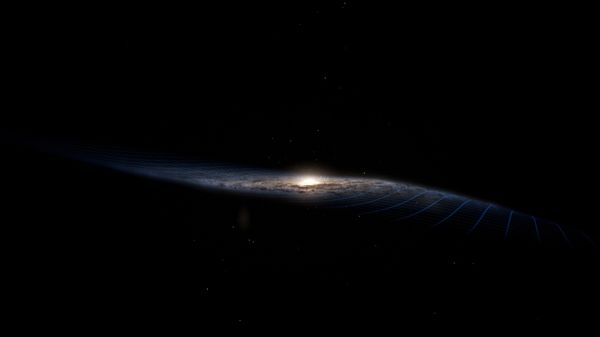Our entire galaxy is warping, and a gigantic blob of dark matter could be to blame
An invisible halo of misaligned dark matter could explain the warps at the Milky Way's edges.

A gigantic blob of invisible dark matter has bent our galaxy out of shape, a new study suggests.
Scientists initially believed that the Milky Way was a flat disk dominated by two spiral arms trailing stars from a central bar, but measurements taken since the mid-20th century reveal that it's bent inexplicably out of shape.
The warping occurs mostly at our galaxy's borders, where some regions bend downward while others flare upward — giving it the look of a crushed sombrero. Now, computer simulations may have revealed the cause: a mysterious event that knocked our galaxy's invisible halo of dark matter out of alignment. The scientists published their findings Sept. 14 in the journal Nature Astronomy.
Related: Self-destructing dark matter may be flooding the sky with gamma-rays, study suggests
"These results, in combination with data in the stellar halo, provide compelling evidence that our galaxy is embedded in a tilted dark matter halo," the researchers wrote in the study.
Dark matter is a mysterious and somewhat contradictory type of matter. It makes up 85% of the universe's matter; but because it doesn't directly interact with light, it is completely invisible.
However, scientists can observe its gravitational effects on its surroundings. Dark matter makes its presence known by accelerating stars to otherwise inexplicable speeds as they orbit galactic centers; warping distant starlight; and by giving shape to the Milky Way's galactic halo.
Get the Space.com Newsletter
Breaking space news, the latest updates on rocket launches, skywatching events and more!
The galactic halo — a vast sphere of stars floating like leaves on a dark matter pond — rests just beyond the spiral arms of the Milky Way. In a 2022 study, astronomers investigated this region using the European Space Agency's Gaia spacecraft, which maps the positions and movements of the Milky Way's roughly 2 billion stars. By poring through Gaia's data, they discovered that the stars suspended in the galactic halo were strangely off-kilter.
To see what an unbalanced stellar halo might mean for the dark matter halo it is suspended in, the researchers used a computer model to recreate a young Milky Way-like galaxy with a dark matter halo tilted 25 degrees with respect to its disk. After simulating the galaxy over 5 billion years, the researchers found that they had created a very similar galaxy to our own.
"Here we show that a dark halo tilted in the same direction as the stellar halo can induce a warp and flare in the Galactic disk at the same amplitude and orientation as the data," the researchers wrote.
What caused the dark matter around our galaxy to fall out of tilt isn't clear, but the researchers' simulations suggest it is likely to have been a gigantic collision, likely from another galaxy flying into our own. This collision could have caused the dark matter halo to tilt up by as much as 50 degrees before slowly swinging down to its current 20-degree angle elevation.
Join our Space Forums to keep talking space on the latest missions, night sky and more! And if you have a news tip, correction or comment, let us know at: community@space.com.

Ben Turner is a U.K. based staff writer at Live Science. He covers physics and astronomy, among other topics like weird animals and climate change. He graduated from University College London with a degree in particle physics before training as a journalist. When he's not writing, Ben enjoys reading literature, playing the guitar and embarrassing himself with chess.
-
Classical Motion I have a different take. I think that star orbits(planet orbits,moon orbits) are helical, not elliptical. And the edge view allows you to see this. And this also is why our star velocities are so off the mark.....that we need to invent another fiction for our solutions. For no matter how obvious it is.....our equations simply can not be wrong. No matter what we see. Decade after decade.Reply -
Questioner "...knocked our galaxy's ... dark matter out of alignment..."Reply
'knocked' makes it sound like a single 'faucet washer' object. Silly imo.
If they start talking about fine particulate matter and the inertia & gravity characteristics, essentially fluid flows how would this stuff hold any fixed form at all? Trying to address that would either arrive at something or expose DM as bogus.
'Dark gravity' is Neil DeGrass Tyson's appropriate term.
Thus far there's only evidence for gravity.
Again DM in a galaxy is intra-galacticly immune to gravity and exo-galacticly attracted by gravity.
DOA IMO.
I guess old academic cliques can't
ever
learn new tricks.










